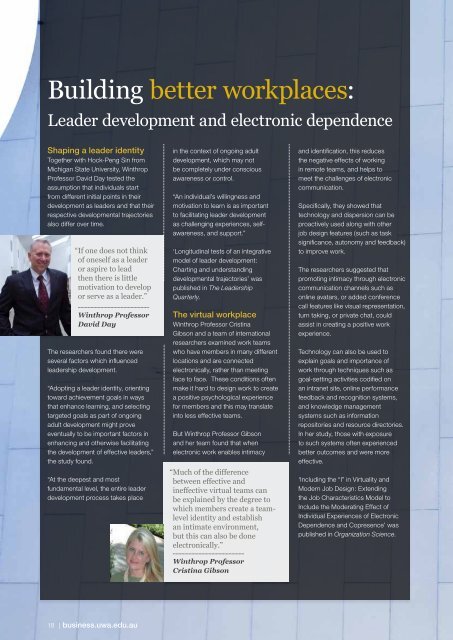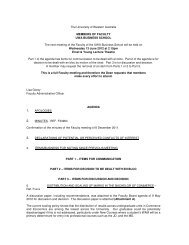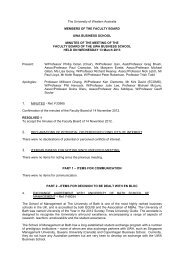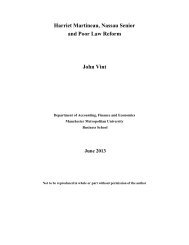UWABS highlights 2012 - Business School - The University of ...
UWABS highlights 2012 - Business School - The University of ...
UWABS highlights 2012 - Business School - The University of ...
Create successful ePaper yourself
Turn your PDF publications into a flip-book with our unique Google optimized e-Paper software.
Building better workplaces:<br />
Leader development and electronic dependence<br />
Shaping a leader identity<br />
Together with Hock-Peng Sin from<br />
Michigan State <strong>University</strong>, Winthrop<br />
Pr<strong>of</strong>essor David Day tested the<br />
assumption that individuals start<br />
from different initial points in their<br />
development as leaders and that their<br />
respective developmental trajectories<br />
also differ over time.<br />
“If one does not think<br />
<strong>of</strong> oneself as a leader<br />
or aspire to lead<br />
then there is little<br />
motivation to develop<br />
or serve as a leader.”<br />
Winthrop Pr<strong>of</strong>essor<br />
David Day<br />
<strong>The</strong> researchers found there were<br />
several factors which influenced<br />
leadership development.<br />
“Adopting a leader identity, orienting<br />
toward achievement goals in ways<br />
that enhance learning, and selecting<br />
targeted goals as part <strong>of</strong> ongoing<br />
adult development might prove<br />
eventually to be important factors in<br />
enhancing and otherwise facilitating<br />
the development <strong>of</strong> effective leaders,”<br />
the study found.<br />
“At the deepest and most<br />
fundamental level, the entire leader<br />
development process takes place<br />
in the context <strong>of</strong> ongoing adult<br />
development, which may not<br />
be completely under conscious<br />
awareness or control.<br />
“An individual’s willingness and<br />
motivation to learn is as important<br />
to facilitating leader development<br />
as challenging experiences, selfawareness,<br />
and support.”<br />
‘Longitudinal tests <strong>of</strong> an integrative<br />
model <strong>of</strong> leader development:<br />
Charting and understanding<br />
developmental trajectories’ was<br />
published in <strong>The</strong> Leadership<br />
Quarterly.<br />
<strong>The</strong> virtual workplace<br />
Winthrop Pr<strong>of</strong>essor Cristina<br />
Gibson and a team <strong>of</strong> international<br />
researchers examined work teams<br />
who have members in many different<br />
locations and are connected<br />
electronically, rather than meeting<br />
face to face. <strong>The</strong>se conditions <strong>of</strong>ten<br />
make it hard to design work to create<br />
a positive psychological experience<br />
for members and this may translate<br />
into less effective teams.<br />
But Winthrop Pr<strong>of</strong>essor Gibson<br />
and her team found that when<br />
electronic work enables intimacy<br />
“Much <strong>of</strong> the difference<br />
between effective and<br />
ineffective virtual teams can<br />
be explained by the degree to<br />
which members create a teamlevel<br />
identity and establish<br />
an intimate environment,<br />
but this can also be done<br />
electronically.”<br />
Winthrop Pr<strong>of</strong>essor<br />
Cristina Gibson<br />
and identification, this reduces<br />
the negative effects <strong>of</strong> working<br />
in remote teams, and helps to<br />
meet the challenges <strong>of</strong> electronic<br />
communication.<br />
Specifically, they showed that<br />
technology and dispersion can be<br />
proactively used along with other<br />
job design features (such as task<br />
significance, autonomy and feedback)<br />
to improve work.<br />
<strong>The</strong> researchers suggested that<br />
promoting intimacy through electronic<br />
communication channels such as<br />
online avatars, or added conference<br />
call features like visual representation,<br />
turn taking, or private chat, could<br />
assist in creating a positive work<br />
experience.<br />
Technology can also be used to<br />
explain goals and importance <strong>of</strong><br />
work through techniques such as<br />
goal-setting activities codified on<br />
an intranet site, online performance<br />
feedback and recognition systems,<br />
and knowledge management<br />
systems such as information<br />
repositories and resource directories.<br />
In her study, those with exposure<br />
to such systems <strong>of</strong>ten experienced<br />
better outcomes and were more<br />
effective.<br />
‘Including the “I” in Virtuality and<br />
Modern Job Design: Extending<br />
the Job Characteristics Model to<br />
Include the Moderating Effect <strong>of</strong><br />
Individual Experiences <strong>of</strong> Electronic<br />
Dependence and Copresence’ was<br />
published in Organization Science.<br />
18 | business.uwa.edu.au
















